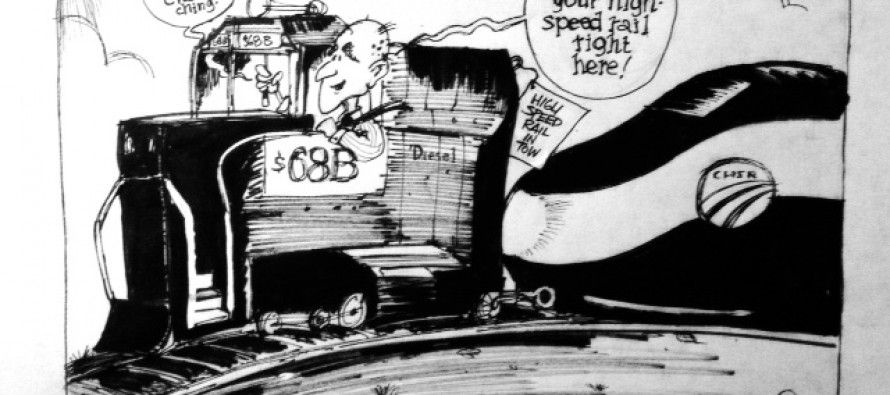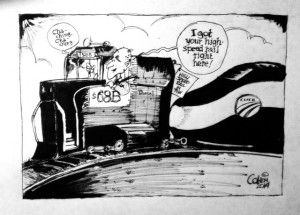New High-Speed Rail business plan mainly raises questions

 This is Part 1 of a three-part series on the Draft 2014 Business Plan of the California High-Speed Rail Authority. Part 2 is here.
This is Part 1 of a three-part series on the Draft 2014 Business Plan of the California High-Speed Rail Authority. Part 2 is here.
There are more questions than answers in the Draft 2014 Business Plan of the California High-Speed Rail Authority released late on Feb. 7 without the normal fanfare. The news is more about what it doesn’t include than than what it does.
There is no mention of specific lawsuits against the train, no change in the construction route, no significant change in cost and no solution for how to bring high-speed rail to Anaheim — all of which was promised at the board’s April 2012 meeting.
As in previous plans, the public is always anxious about project cost. But there’s no roller-coaster ride this time because, despite time delays and surprise issues in the Central Valley, the projected construction costs actually dropped a little, from $68.4 to $67.6 billion.
Anaheim excluded
In 2008, the Legislature passed Assembly Bill 3034, putting on the ballot that November Proposition 1A, the High-Speed Rail Act, which voters approved. AB3034 specifically included Anaheim in Phase 1 of the rail’s construction. In 2012, Anaheim first was taken out of the project, then put back into the April 2012 Final business plan.
Now Anaheim is out of the Draft 2014 Business Plan. And the $6 billion in costs costs attributed to the Anaheim line in earlier years have been used to reduce the overall program costs to $68 billion, down from the $98 billion November 2011 draft.
The 2014 plan now carries the high-speed train riders between Los Angeles and Anaheim aboard the low-speed Metrolink.
David Schonbrunn is the president of the Transportation Solutions Defense and Education Fund, known as TRANSDEF, a non-profit environmental organization created by transit activists to advocate for better solutions to transportation, land use and air quality problems in the San Francisco Bay Area. “Metrolink is all-diesel and the only relatively cheap way to make a one-seat ride is by adding a diesel locomotive,” he said in an interview.
A “one-seat ride” means not leaving the train. To do that, the high-speed rail train, which is electric, would have to be hooked up to a diesel train from San Francisco to Anaheim for the part of the line running between Anaheim and Los Angeles.
Such piggybacking actually is done in Europe, for example in France between Nantes and La Rochelle, according to Richard Tolmach, president of California Rail Foundation. However, he thinks it is doubtful Anaheim residents, and local politicians such as state Sen. Lou Correa, had this in mind when they backed the high-speed rail project.
No changes to the operating segment
The Draft 2014 Business Plan also doesn’t take into account recent legal developments that could scuttle the entire project. Last November, Sacramento Superior Court Judge Michael Kenny, reported the Fresno Bee, “denied a request by the California High-Speed Rail Authority to issue a blanket validation for the sale of more than $8 billion in bonds from Proposition 1A, a high-speed rail measure approved by California voters in 2008.”
In a separate ruling last November in the Tos/Fukuda/Kings County case, Judge Kenny ruled the CHSRA was required to rescind the funding plan. The reason: the environmental work was not completed and the funds to build the operating segment were not identified.
But the CHSRA has not rescinded the funding plan. Instead, it is barreling full speed down the track with the old plan for construction.
On Jan. 15, CHSRA Board Chairman Dan Richard testified before the subcommittee on railroads, pipelines and hazardous materials of the Committee on Transportation and Infrastructure of the U.S. House of Representatives. According to the House transcript, he replied that the rail project is similar to other controversial projects, such as the Golden Gate Bridge, that faced legal and other obstacles but overcame them:
“Over 2,300 lawsuits were filed to stop construction of the Golden Gate Bridge. The California State Water Project passed by a single-vote margin. Decades later, no one in California regrets those tough decisions. Their impact on our economic prosperity has been enormous. Where would California be if leaders at the time had not persevered?
“While I do not want to minimize the import of recent decisions regarding the high-speed rail program in California Superior Court, the reality is that dealing with those sorts of challenges is the nature of delivering major, and in this case, generational infrastructure projects. We will address and resolve them.
“As we determine the best way to respond to the court rulings, California remains in compliance with the terms of our grant agreement with the U.S. Department of Transportation and we will continue to work closely with them.
“Furthermore, it is important to note that California has already issued $400 million in Proposition 1A bonds that have been used to advance the program to this stage. Since entering into the Grant Agreement with the Federal Railroad Administration (FRA), approximately $100 million in state funds have been spent against $275 million in federal dollars. The state is continuing to contribute money to the program and meet its obligations under the
Grant Agreement.”
And he pointed to construction proceeding on the first segment, called the Initial Operating Section:
“We have also made significant strides on the second construction package of the first construction segment in the Central Valley, known as CP 2-3. In October 2013, the Authority started the process of selecting a design-build contractor for CP 2-3 by issuing a Request for Qualifications. On December 18, the Authority received five bids from world-class construction teams to finish the design work on and then build this 60-mile extension from Fresno to north of Bakersfield.
“The estimated $1.5 to $2 billion contract will also bring thousands of jobs to the Central Valley while continuing completion of the IOS.”
Cost reduction
The Draft 2014 Business Plan’s included a modest cost reduction, from $68.4 to $67.6 billion. It did so by changing the cost assumptions, mainly in four areas:
- The medium level ridership is projected to rise by 25 percent;
- Operations costs are expected to rise by 15 percent.
- Annual inflation is assumed to drop from 3 percent in the original assumption to 2 percent.
- Revenues are seen to drop by 5 percent in 2025 and by 10 percent in 2040. Yet the CHRSA still projects project will not need a subsidy.
(Author’s note: The cartoon at the top, called Anaheim High-Speed Rail, was drawn by Russ Cohen for this article.)
Related Articles
Brown’s new budget attacks producers
May 14, 2012 By John Seiler Gov. Jerry Brown’s May Revise to his 2012-13 budget proposal, released today, only will
Will California repudiate its debt?
AUGUST 12, 2010 By JOHN SEILER California’s government soon could be paying its bills with IOUs, Controller John Chang announced
Cap-and-trade share not close to $ bullet train needs
Gov. Jerry Brown has managed to secure a steady source of funding — cap-and-trade fees related to AB 32 —




